|
This review page is supported in part by the sponsor whose ad is displayed above
|
||||||||||||||||||
 |
||||||||||||||||||
| As this is both my first review of a turntable and my first intimate experience with a deck at this price and performance level, I won't pretend a more worldly grasp of the MS2's competition than I have. To that end, I can say with certainty only that as outfitted, the MS2 is better than twice the price of my Rega P9, which itself is whispered by people in the know to be a player of high value. I can say that while you pay more for the MS2, you also get more. In terms of what it takes to make for a more believable music experience in the home, you get much more. But given my relative lack of context for what the market holds at this price point, rather than preaching to the converted -- those already well acquainted with 'tables of this caliber -- it seems more appropriate to direct my efforts, at least to a significant extent, at the uninitiated. It's getting more and more difficult to find a table of the MS2's caliber for audition. I may be of greatest service to the greatest number of readers if I try to convey what the MS2 brings to the table so to speak that neither the digital medium nor lesser tables have thus far. In all my years of reading reviews, I've read precious little about exactly how and why vinyl can be superior to digital. It's that revelation I want to share. |
||||||||||||||||||
 |
||||||||||||||||||
There are two things about the MS2 that make a bold first impression. One is its effect on record noise. I've noticed before that the better the table, the quieter record noise becomes and even more importantly, the more out of context with the music or de-correlated the clicks and pops become, making them easier to listen past and ignore. Really good 'tables produce soundstages as big and spacious as it gets. They also have the effect of banishing this noise clatter to the outermost regions of the stage. Rather than hearing it peppering the music and the stage, you hear it coming from the outer perimeter. My Rega P9 does this and the MS2 does it even better. Additionally, drop that noise in level and it becomes of even less relevance. Unlike any 'table I've experienced in my room, the MS2 makes record noise a non-issue as even the oldest and most worn records in my collection find new life. That won't come as news to a lot of readers experienced with high-end analog but it's something that may come as news to those raised on CD. The second thing that may just bowl you over is the sheer sonic intensity as well as tonal saturation retrieved from records vs. the same recordings on CD. Think dark Bavarian beer as opposed to any domestic lite. The MS2 produces images with greater weight and presence than I've ever experienced. Tonal saturation is such that a CD of the same recording sounds washed out, lacking in weight and resolution. The MS2 produces much greater weight and density vs. the CD's lighter and more ethereal representation. The MS2 produces musicians that are much more there as opposed to the more ghostly apparitions produced by digital. |
||||||||||||||||||
 |
||||||||||||||||||
When I cued up Hall & Oats Rock And Soul Part I, I thought the MS2 was producing bass with both greater extension and impact than the CD version. This turned out to not be the case. Both the CD and LP produced very similar extension and impact yet the MS2 resolved far greater body and more palpable detail. It imparts an almost visual sense of space. I could almost see the dimensions of the soundstage as the bass illuminated it. Good bass just does that. There it was again, that visual sense the MS2 brought to the music. The music was so solidly manifest, I could almost see it. |
||||||||||||||||||
 |
||||||||||||||||||
| To illustrate what I mean, turn up the brightness on your monitor and watch the density of the image diminish as all contrast is washed away. That's what CDs now sounded like. Drop the brightness (or bring up black levels) and the image becomes more solid, three-dimensional and tangible - more there. That's the MS2. After a short session with the Merrill/Scillia, CDs sound thin, anemic and watered down - much less convincing. |
||||||||||||||||||
 |
||||||||||||||||||
| "Riviera Paradise" from Stevie Ray Vaughn's In Step just melted away the walls in my listening room. The soundstage again was huge and vividly dimensional and also had an almost reach-out-and-touch realism. This was no paper cutout children's diorama but an easily sensed | ||||||||||||||||||
| representation of space with uncanny depth, width and height. Of course, the soundstage wasn't the only thing with a newfound sense of dimensionality and presence. SRV's guitar swelled with a natural authenticity and presence as it never did before. Its sound was so warm and thick with layers of tone, I could almost cut it - or at least touch it. I suppose we're not quite at the point where we can be fooled into believing to be in the presence of the real thing, but the MS2 was taking me farther in that direction than I'd gone before. |
||||||||||||||||||
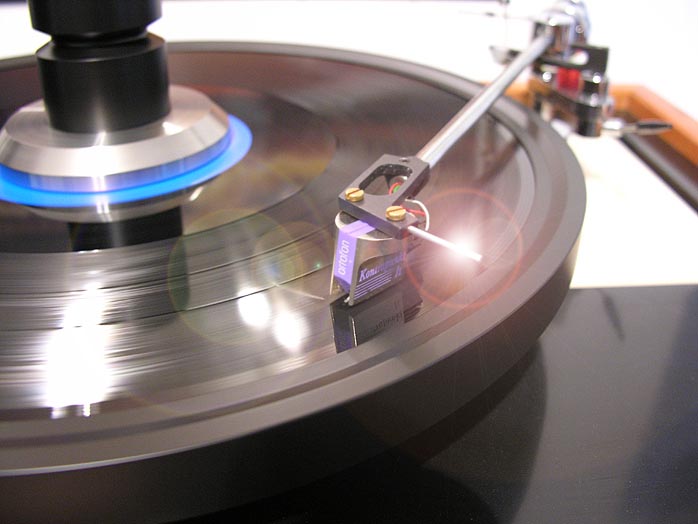 |
||||||||||||||||||
The analogy to the black level in your monitor's image holds true for the MS2's depiction of tone and nuance, too. As the black level decreases, the picture becomes grainier and washed out. Greater saturation of color and black levels replaces the grain with nuance and contrast. The MS2 accomplishes the same thing and, frankly, I didn't know much of my vinyl had so much on tap. Supertramp's Crime Of The Century is a recording I've owned and enjoyed since the 70s, first on record, then on CD and then on vinyl again. Thirty years after its introduction, I'm hearing the recording as I never have before. Even the vinyl had always struck me as flat and two-dimensional; and I'm not referring to soundstaging but tonal and textural contrasts as well as dynamics. Suddenly I heard microdynamic nuance and, in turn, a sense of greater expressiveness. Greater harmonic saturation brings all instruments to life with -- here comes that word again -- palpability as never before. |
||||||||||||||||||
 |
||||||||||||||||||
| Palpability may be one of the MS2's most differentiating traits. If that were all it brings to the table over and above my own turntables and digital system, would that be enough? When it comes to the creation of the illusion of live music, its importance cannot be overstated. As mentioned earlier, I had on hand the same Hadcock 228 Export arm outfitted with both a Garrott Bros. Optim FGS Cartridge and the Ortofon Kontrapunkt H. As I swapped arm tubes in favor of the much less expensive Garrott Brothers Optim FGS cartridge, it was easy to separate the contributions of the thrice-the-price Ortofon and MS2. The Ortofon is certainly the better cartridge. It excels at smoothness and musicality, making the Garrott Brothers sound rougher, grainier and less fluid. Still and for its asking price, the MS2 elevated the inexpensive Garrott Bros. cartridge to unanticipated heights. The combination had the same gravitas as the Ortofon and while it was grainier and a little rougher than before, it still sounded awfully good, exhibiting the same list of strengths, albeit to a slightly lesser degree. Only after a direct comparison was I made to (almost) feel as though I was suddenly slumming it with the cheaper Garrott. And when I dragged into the room my highly modified AR and installed the same Hadcock and Garrott Bros. cartridge to remove the MS2 from the equation... well, suddenly I wasn't feeling so good about the AR. Even with the Ortofon installed, the AR's bass suddenly sounded thicker, slightly congealed and opaque. The soundstage shrunk dramatically and everything on that stage became less illuminated as musical presence was greatly diminished. |
||||||||||||||||||
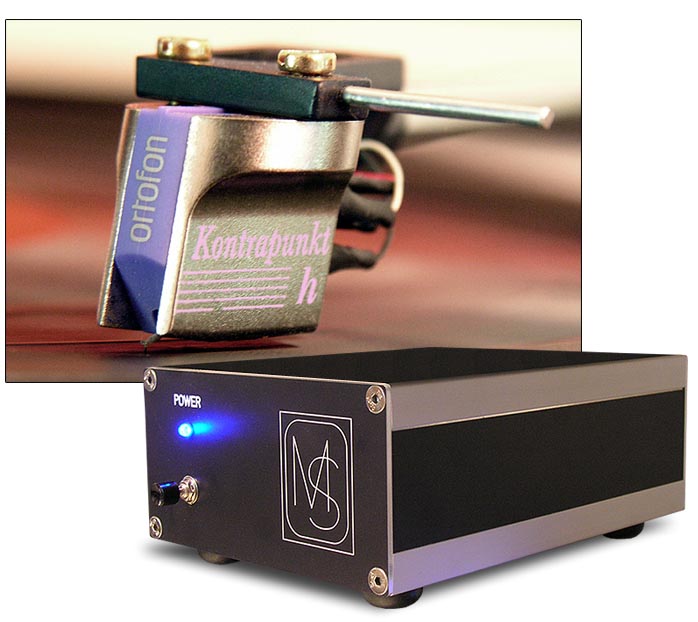 |
||||||||||||||||||
| I do have a few words of caution, however. First, the blue LCD on the power supply is bright. If you listen in the dark, be prepared to deal with its piercing luminance. I'd suggest to the folks at Merrill/Scillia that it needn't be that bright. Perhaps they should tone it down. The other caveat, if I can even call it that, goes out to potential users. While this is a suspended turntable, it's not totally impervious to outside influences. You'll want to provide the MS2 with a good support and place that support on a firmly braced floor. My room has a springy floor and it caused me some problems as floor-induced vibrations and extremely low-frequency resonance made their way back into the arm and cartridge to create some infrasonic woofer pumping. I couldn't hear it, being somewhere in the vicinity of 10 and 15Hz. But it was there. When I unspiked my speakers, it all went away. A conversation with George Merrill confirmed that this was indeed a consideration with a 'table of this type. To paraphrase: any 'table that doesn't act as its own high-pass filter -- one that can retrieve the lowest bass fundamentals in all their authority -- will require more attention to a stable mount than I was able to provide with the MS2. That is to say, any 'table that can dig so deep into the bass frequencies as the MS2 does, runs the risk of exciting resonances as never before. That should surprise nobody. All the world's super tables (and super expensive ones) come with their own platforms, the need for it taken for granted by their designers. To be clear, we're not talking about airborne acoustic feedback. Far from it. Despite extremely close proximity to speakers and enthusiastic levels, at no time did I ever encounter such a thing. |
||||||||||||||||||
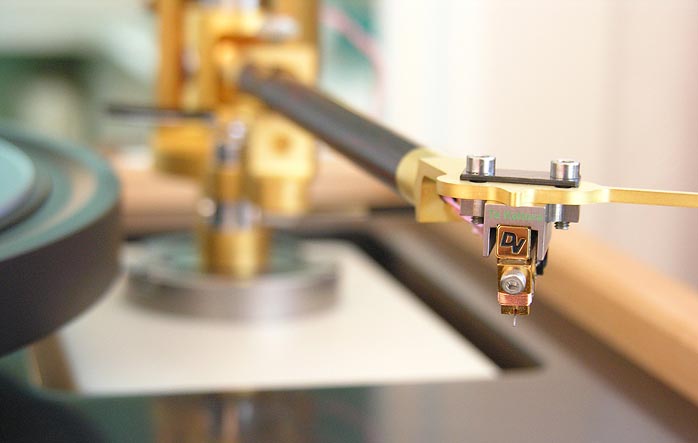 |
||||||||||||||||||
In my recent 13th installment of our RoadTour series, I had opportunity to hear the MS2 decked out with the much more ambitious (and $7k!) DaVinci tone arm and $2700 Dynavector Te Kaitora cartridge. In most respects, the sound was simply beyond reproach. But the table was installed on a portable Black & Decker workbench that just didn't offer the mass to decouple the table from the floor. Even so, the bass produced by the Merrill/Scillia/DaVinci/Dynavector system was something to behold. Deep bass-infused pipe organ was reproduced with phenomenal detail, power and extension. It may sound plebeian to some and a little naïve to others to bring up again in a review of a turntable in this class but to those without experience, I have to reiterate that record noise was almost non-existent. At the same time, breath, depth and scale were amazing. When used in conjunction with Bill LeGall's tweaked-out Infinity IRS speakers, it was quite possibly the best playback of music I've ever experienced. In this or the much less ambitious setup I used at home, it was the first time I'd ever experienced analog crush the digital process such as to make the latter seem outright anathema to the reproduction of real music in the home. |
||||||||||||||||||
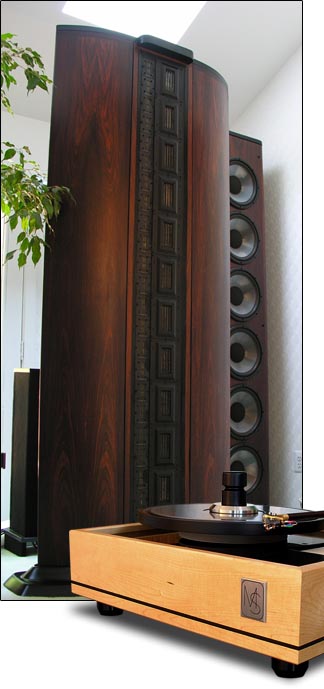 |
||||||||||||||||||
| The MS2 provides the kind of holography and focus that make Miles Davis' Kinda Blue [Columbia PC8163] absolute magic. Davis and crew are lined up across a deep and dark stage illuminated beautifully by reverberation and echoes. Keyboards and percussion are so clearly behind the horns that you feel you can walk up and tap each one of them on the shoulder. Paul Chambers' upright bass is so full and fleshy, balanced and | ||||||||||||||||||
| articulate that it defines the term delicate thunder. The horns exhibit the same in-the-flesh presence and realism previously ascribed to just about everything produced by the MS2. Coltrane's tenor sax comes across with a measure of dexterity perfectly complemented by Adderly's alto sax. I'm not sure that the ability to almost see these guys on stage helps drive home their interplay more but it sure doesn't hurt! I honestly couldn't decide whether these guys were in my place or I in theirs. There was immediacy and verve to the entire presentation that suggested my place but | ||||||||||||||||||
 |
||||||||||||||||||
| the walls of the room were erased as my digs were transformed to a venue several times its size. I may not have been sure where I was but I know I liked it. |
||||||||||||||||||
 |
||||||||||||||||||
The MS2 produced Korsakoff's Scheherazade [Reiner, Chicago Symphony, RCA LSC 2446] as if completing its life's mission. This recording sounded as though it was the MS2's raison d'être. Did it come across as perhaps just a little larger than life? Arguably so. But sweet lord, it was fabulous and guaranteed to get the blood pumping as its grand scale certainly served the piece. By any measure, the MS2 did its part in the finest recreation of this piece I've ever experienced. From the natural delivery and contrasting of instrumental timbres to the near jaw-dropping microdynamic shading to the almost eerie sense of dimension and spatial cueing, this truly was a feast for the ears and the soul. It may have been the greatest event experienced during the MS2's stay here. From the delicate swell of the plucked double basses to the soaring violins and crisp snare drums tapped in near-perfect unison, the MS2 just pulled out all the stops for not only one of the more emotionally stirring renditions I've heard but one of the more believable. Conclusion |
||||||||||||||||||
 |
||||||||||||||||||
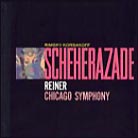 |
||||||||||||||||||
| As a company, Merrill/Scillia Research is fairly new. But make no mistake, the MS2 is a mature concept superbly executed. George Merrill has been in the business of turntable design and modification for decades and he's brought a wealth of knowledge to the project. For | ||||||||||||||||||
| his part, Anthony Scillia brings expert close-tolerance machining and mechanical know-how. (Rumor has it that if you're in need of such machining/design prowess, his guns are for hire.) Together the two men combined their talents for a remarkably developed product that's easy to set up, easier to use and sounds like nothing I've heard before. I can't tell you how the Merrill/Scillia MS2 turntable compares to like-priced competition. I can't tell you how it stands up against 'tables at multiples its price. That's not what this review was about nor ever my intent. I can tell you that it's the best-sounding musical source I've ever used and redefined for me just what vinyl is capable of. I can also tell you that the MS2 opened my eyes and ears as to just how fantastic music can sound in my own room. The MS2 isn't cheap but it's a lot less expensive than other decks and right on par with the cost of my digital source, which it stomps. As well, what I'd gotten in my room represented the MS2's entry-level. Outfitted with a better arm and cartridge, its performance soared even higher and the mind boggles over what only a few months ago had been unimaginable possibilities. |
||||||||||||||||||
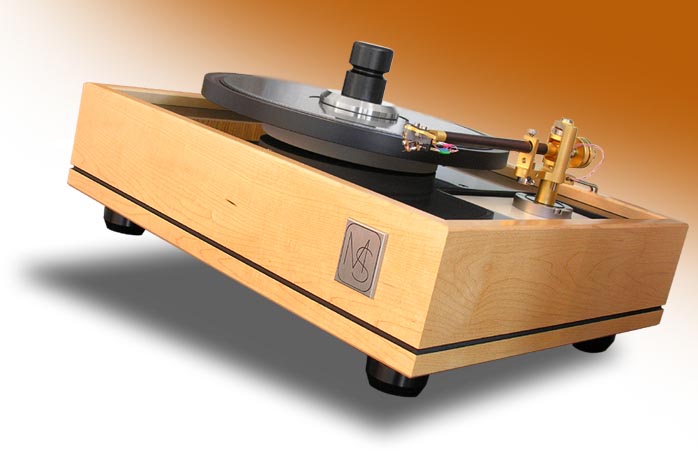 |
||||||||||||||||||
An unmitigated rave then? Well, no. There is that way-too-bright blue light on the power supply. But nothing's perfect. If you're looking into a turntable upgrade or just want to hear what is possible from great vinyl playback, seek out the Merrill/Scillia Research MS2. It's a wondrous creation. |
||||||||||||||||||
PS: Three weeks after completion of the review, John Potis couldn't stand the notion of being without the MS2. He purchased the loaner to upgrade from his Rega for another entry into our secret black book of Addiction Afflictions - Ed. |
||||||||||||||||||
| Quality of packing: NA -The 'table was delivered and set up for me. Reusability of packing: NA - never really saw it. Ease of unpacking/repacking: Unlike most components these days, turntables have lots of mechanical moving parts and require disassembly before shipping or transporting. Condition of component received: Flawless. Completeness of delivery: Perfect. Website comments: Informative with lots of good information including White Paper. Warranty: 5 years, transferable. Human interactions: Top-notch. Pricing: More expensive than a lot, much cheaper than many, cost not threatening that point of diminishing returns. Final comments & suggestions: How 'bout an MS1.5 that I can afford? |
||||||||||||||||||
Manufacturer's Response: On behalf of George Merrill, the original designer of the Heirloom table and our distributor Vinh Vu of Norvinz, I would like to thank John Potis and 6moons for a wonderful review! As a new and fledgling company, which was born out of a once existing enterprise, we strive to offer the best performing products at a fair price, coupled with great and personable service. From the review it seems that the MS2 has given John Potis a medium to connect with the musical performers in a manner that transcends time and space, an intangible quality that tells us that we are successful in not only creating a high-quality audio product but also a musical tool to reach the heart and soul of the listener. We are honored and humbled by the accolades. My personal goal was to develop Mr. Merrill's designs and take them to a new level of workmanship, performance and quality, which I hope I have accomplished. We would also like to note that we have implemented a solution to the problem of the overly bright LEDs. Future production will be equipped with dimmer green LEDs on both our digital 2 speed and single speed drives that are conducive to a pleasurable listening environment. |
||||||||||||||||||
Anthony Scillia Owner/Operations manager MSR, LLC |
 |
|||||||||||||||||
 |
||||||||||||||||||
 |
||||||||||||||||||